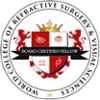Laser Eye Surgery Procedures: PRK/LASEK vs LASIK

Today, it can be easy to become overwhelmed by the apparent range of Laser Eye Surgery procedures available. As you research different clinics, you might think that each provider offers their own range of unique treatments – but this isn’t the case. Rather, different clinics tend to give the same treatment different names. In reality, though, there are only three main Laser Eye Surgery procedures: PRK/LASEK (the surface procedures), LASIK, and ReLEx SMILE.
Each of these procedures involves reshaping the cornea to adjust the eye’s focusing power. What differs is how access is gained to the corneal tissue. In this article, we’re taking a closer look at the differences between PRK/LASEK and LASIK.
The Surface Procedures
Laser Eye Surgery was first developed in the late 1980s. Back then, surgeons didn’t have access to the same technology we have today. As a result, access to the cornea relied on more primitive methods. The first procedures carried out under the umbrella of Laser Eye Surgery were the surface procedures: PRK and LASEK.
Photorefractive keratectomy (PRK)
Photorefractive keratectomy (PRK) was the first procedure to be introduced. In PRK, the epithelium (surface layer) of the cornea was originally removed manually, either by using an oscillating blade or by loosening the tissue with rubbing alcohol. More recently, however, the femtosecond laser can be used to remove the tissue. In this case, the procedure is called “trans-PRK”.
The excimer laser is then used to remove pre-determined areas of corneal tissue, hence reshaping the cornea. Following the PRK procedure, the treatment area is left exposed and covered with a protective soft contact lens. The cells of the epithelium then grow back naturally, recovering the cornea. This usually takes around 4-5 days.
While this method is still considered extremely effective, it is associated with longer healing times than newer Laser Eye Surgery procedures. Unfortunately, this means that the vision is blurry until the cornea has fully healed, which can take up to 3 months. See our full guide on What to Expect Before, During, and After PRK!
Laser Epithelial Keratomileusis (LASEK)
In recent years, PRK has been modified into other techniques, such as LASEK and Epi-LASIK. The main difference between these procedures and PRK is that following your treatment, the removed area of epithelium is put back into place, covering the exposed area of the cornea.
In contrast to PRK, in LASIK, the removed area of epithelium is replaced after the treatment. The hypothesis behind this was that it would take less time for the eye to heal and reduce the risk of discomfort and other side effects following treatment. However, scientific studies comparing the different treatment types have yet to find a significant difference in terms of pain, visual recovery, or outcomes.
In Epi-LASIK, a specific method is used to lift the epithelium from the eye in a single sheet using an epi-keratome device. This is similar to a microkeratome that may be used to create a LASIK “flap” (more on this later) but has a blunter blade.
Despite their differences, all of these procedures are grouped under the term “surface ablation”. This is because they all involve performing the laser treatment on the surface of the stroma (the main body of the cornea underneath the epithelium) rather than deeper in the stroma under a flap as in LASIK.
LASIK: A new way to do things
Laser-Assisted In Situ Keratomileusis (LASIK) was first introduced in 1989 and introduced the microkeratome – a precision surgical device used to create a “flap” in the cornea. It quickly gained popularity as the first Laser Eye Surgery procedure that didn’t require removing a whole section of epithelium. Today, most clinics in the UK use a high-precision femtosecond laser to create the corneal flap.
The LASIK flap created a doorway to the corneal tissue beneath. The instrument is used to cut a circular flap, about one-tenth of a millimetre in thickness, including the epithelium and some of the stroma. This door could be easily closed once the treatment was complete, returning to its natural position.
As only the edges of the flap need to heal (a process that begins as soon as the tissue is put back in place), the cornea regains much of its structural integrity within just a few hours of the procedure. The less invasive and more efficient nature of LASIK saw it quickly become the most popular type of Laser Eye Surgery – which it remains to this day! Learn more about What to Expect Before, During, and After LASIK.
Which is the Better Option?
As a less invasive alternative to PRK and LASEK, patients experience faster recovery times, with many able to return to most normal activities the very next day. Moreover, many patients will notice an immediate improvement in their vision – though it is important to note that fluctuations are normal, alongside other temporary side effects.
But LASIK isn’t the best option for everyone. For example, patients who have dry eyes or thin corneas may be recommended PRK/LASEK as their eyes may be unsuitable for creating a LASIK flap. Moreover, those who partake in contact sports may find PRK/LASEK a better option as there is less risk of displacing the epithelium.
Nonetheless, whether you have myopia (short-sightedness), hyperopia (long-sightedness), presbyopia, or astigmatism, LASIK is the industry standard you will find in most clinics today. In fact, surface ablation procedures are only performed in around 5-10% of patients where LASIK is not suitable.
If you’d like to learn more about the Laser Eye Surgery treatments at the London Vision Clinic, get in touch with one of our friendly clinic coordinators today. Alternatively, Book a Consultation to find out if you could be suitable (most people are!).


